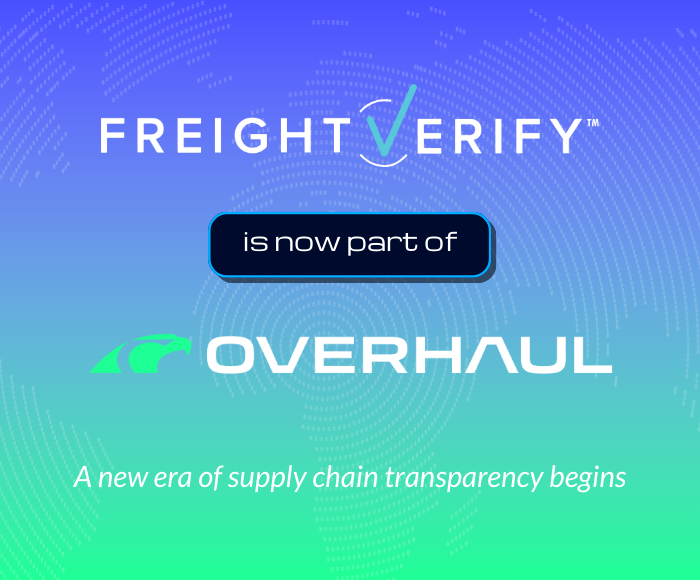The world of pharma is primarily concerned with patient health. And ensuring your patients’ well-being often relies on the health of your supply chain. Pharmaceutical transportation involves multiple stakeholders and uncontrolled environments. Your company must have visibility into these risks and be ready for whatever comes next.
To help you prepare, here’s a look at 4 pharma transportation best practices, from visibility logistics to investing in insurance:
Pharmaceutical Transportation Best Practices
1. Activate Real-Time Visibility for all Pharma Shipments
Visibility solutions help companies keep track of pharmaceutical shipments from beginning to end. With real-time monitoring, you’ll know immediately if something goes awry. And with real-time notifications, you can mitigate impact and protect the integrity of your products.
“In-transit visibility solutions have become table stakes for the healthcare industry,” said Amy Shortman, Overhaul’s VP of Product Marketing. “However, visibility of product-level condition and location, in conjunction with what’s happening around the shipment, are critical in order to ensure compliance and transparency.”
If a driver takes a wrong turn or is otherwise held up, you’ll know to update your customer’s ETA. Many pharma shipments are time-sensitive, so this insight is invaluable. You’ll also be able to see any temperature changes that could cause medicine to spoil. And with risk monitoring, you can step in and address concerns before they become a bigger problem.
2. Utilize Risk Monitoring to Prevent Theft and Spoilage
Visibility is important, but seeing an issue and being unable to correct it is more frustrating than helpful. Through active risk monitoring, you can prepare for, spot, and address supply chain hurdles in real-time.
“Pharmaceutical products need to be transported within time and/or temperature ranges to preserve the integrity of the product and ensure efficacy,” said Shortman. “With risk monitoring you are alerted to deviations that support your teams to take corrective actions.”
Temperature control is only the beginning. Efficient risk monitoring technology also enables you to spot potential cargo crimes. And in a worst-case scenario, risk management helps you work with law enforcement to track and return stolen shipments.
3. Meet KPIs with Compliance Monitoring
Rules and regulations are an essential part of the pharmaceutical industry. These rules ensure that medicine is manufactured and then transported to GxP standards so that patients receive products that are safe and effective.
In the supply chain, compliance is equally important. Here, it refers to local, national, and international shipping regulations, as well as the rules you set forth for your drivers. All must be abided by in order to ensure the legal transport and integrity of your pharma products.
“Visibility allows you to check for compliance issues like double-brokering or unapproved co-loading,” said Shortman. “If you have specific rules for your drivers, like where they should stop for breaks, compliance technology is key. That way, you can clearly communicate requirements, see that they’re being met, and update your KPIs based on their effectiveness.”
In this way, compliance can also help pharmaceutical companies avoid high risk situations. In turn, it becomes easier for shipments to reach their final destination without interference.
4. Prepare for Worst-Case Scenarios with Insurance
The goal of pharma logistics is always to deliver products on-time, to the correct location and in optimal condition. However, even with all the proper technology and procedures in place, sometimes, this doesn’t happen. Theft, acts of nature, and other unexpected events can cause a shipment to be derailed. When cargo is destroyed or lost, it becomes obvious: insurance coverage is non-negotiable.
“Transporting pharmaceutical products is inherently risky,” said Shortman. “If you lack the proper processes and partners, you might be left with stolen or damaged prescription drugs. Even if you do everything right, an unexpected event could still cause problems. For that reason, you need to prepare for the worst and consider cargo insurance.”
Pharmaceutical Transportation Best Practices: A Summary
Handling and transporting shipments can be difficult for pharma companies. Annually, failures in temperature-controlled logistics cost the industry nearly $35 billion. Lack of oversight and compliance allow counterfeit drugs to enter the ecosystem. And cases of theft result in monetary loss while enabling criminals to illegally distribute drugs.
The pharma industry will continue to face these and related obstacles when shipping pharma products. But by following the tips above, you’ll be better equipped to identify potential issues and prevent your shipments from harm.
The right supply chain partner can help make pharmaceutical shipping easier and more effective. Overhaul’s team has the skills and expertise to supply the visibility, risk monitoring, compliance tools, and insurance you need. We’re not doctors, but we provide the best treatment for supply chain management and pharma logistics. Let us focus on your shipment’s health so you can focus on the end goal: patient health.
If you want to learn more about Overhaul’s pharmaceutical supply chain best practices, reach out to us today.






